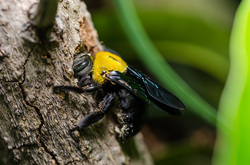When does an insect become a pest?

Take a look at this little guy buzzing in the video above. In the spring, he happens to be a wonderful pollinator. This bee is often mistaken for a honey bee. You would never know that he is a wood boring bee, known as the Carpenter Bee (Xylocopa spp.). Carpenter bees construct nests in exterior wood such as siding, fascia boards, porch ceilings, window sills and trim. A round entrance hole is a chewed in the wood surface then a tunnel is bored that can be used year after year. This tunneling eventually weakens the wood. Entrance holes can allow water to get in and cause wood to rot. Not to mention, can later be used as infesting areas for other pests, such as beetles, moths, wasps and ants.
Pest control is about knowing the biology, habits and management of each insect we come across. Each of these elements determines how we will go about developing a custom pest control plan that is not only considerate of the customer's needs, but also conscious of the benefits of each insect in it's natural environment.
Whether found in the forest or around blooming flowers, the carpenter bee is in it's natural habitat. However, if you find your home or garage is riddled with carpenter bee holes, we recommend treatment to the immediate area, as well as caulking or repairing the holes to prevent bees from enlarging the tunnels year after year.
Here are a couple of tips for prevention and identification:
Because unfinished wood surfaces are more likely to be attacked than finished wood, painting or staining is also recommended to resist carpenter bee attack. Prevention is always best.
If you notice yellowish or brownish stains on the side of the home, just below entrance holes, you may have a problem.
You may notice the adults in spring and summer.
As you can see there is a lot of knowledge behind every pest control treatment, making each job interesting and challenging.

 RSS Feed
RSS Feed